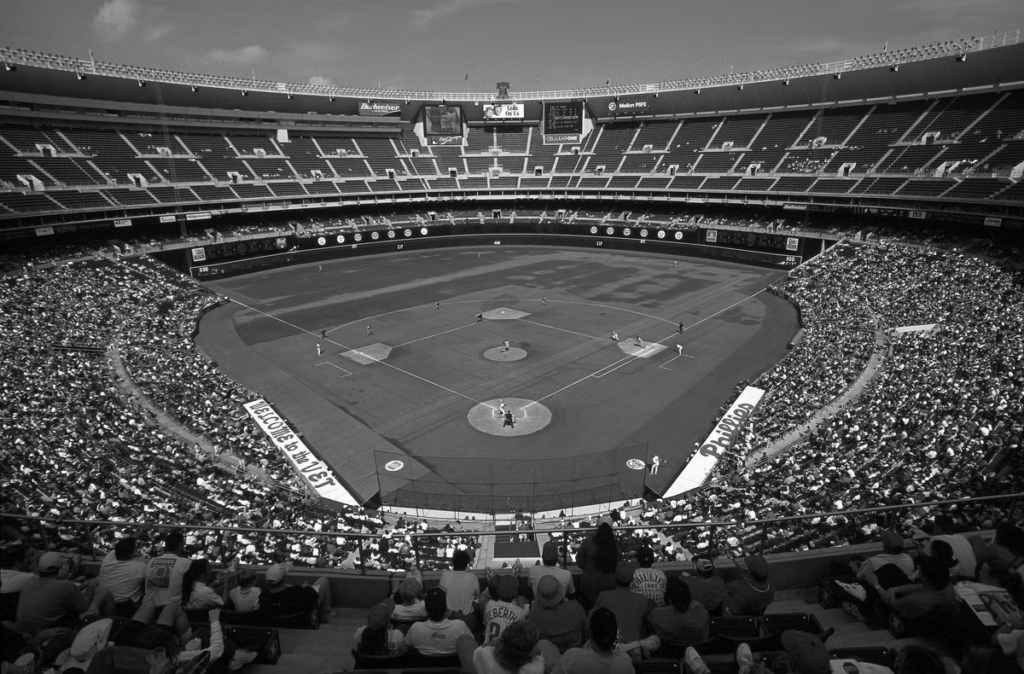HOME FIELD
ADVANTAGE:
THE COMMUNITY
EXPERIENCE IS
PARAMOUNT
My love for sports began when I was little. In the early 80’s my Godfather drove me and my dad an hour south and a toll-bridge away to Vet’s Stadium in Philly to see the great Charlie Hustle in action. Pete Rose had shown up in 1979 from the Reds with a then-unheard-of, four-year, $3.2 million free-agent contract, and the year after that, he led the Phillies to their first World Series win ever: It was a big deal. And in case I hadn’t picked up on that, he even said, “When you’re older, you’ll remember your Godfather took you to see Pete Rose.” So what?
Pete Rose’s reputation was tarnished less than a decade later because gambling allegations forced him to accept a ban from baseball that lasts to this day. Doesn’t matter. I remember being in these shitty outfield seats at the Vet, and my Godfather was so proud. For me and the men in my family, that experience, and that camaraderie still resonates today. It always goes back to the game, and the common experience that unites a community of fans.
Fast forward to 1993: In between Marlboro Lights in the dugout, Lenny Dykstra leads the Phils to a 4-2 series victory over the division rival Atlanta Braves, only to get shut out by the Canadians in the World Series. The 1994 MLB strike hits --- hey, remember the 1981 strike after the 1980 series? --- and it takes another 15 years for the Phils to return, and win their second World Series. The Phils are playing the Braves again, and reports of bargain $300 tickets have already become commonplace. If the Phils make it to the Series again, what’s the over-under on another MLB stoppage/strike to deal with next season in full curse fashion?
Just like the Vet is history, so is how we as fans connect with our sport, our tribe, and our adrenaline club, and the number of ways to experience that fandom has exponentially increased along with the technology we’re experiencing it through. While established pro leagues like the Big 3 (NFL, MLB, and NBA), which are competing for those finite number of eyeballs, think they are using tech to guide the fan experience, it’s the opposite that’s true. Sports fans are going to be the ones using tech to dictate the future of sports, both in the experience and in the business of providing it.
Once upon a time, the Big 3 were the disruptive distractions of their day, upstart start-ups of the Victorian era, where the Industrial Revolution and labor reforms reduced a 12-hour workday to an eight-hour one that promised a two-day weekend, creating the novel concept of leisure time. Baseball was invented by Abner Doubleday sometime before the Civil War, football developed out of the Rutgers and Princeton scrimmages in New Jersey which formed the basis of the Ivy League, and basketball was a YMCA calisthenics routine developed by James Naismith. By the turn of the century, all this organized watching of grown men chasing balls around had become big business.

“Sports fans are going to be the ones using tech to dictate the future of sports, both in the experience and in the business of providing it.”
“Today, we’re living through our own revolution, as the computer, gave way to the internet, gave way to the smartphone, gave way to the cloud, and now AI.”
Today, we’re living through our own revolution, as the computer, gave way to the internet, gave way to the smartphone, gave way to the cloud, and now AI. We still want our games, and our idols, and to shout our war cries in unison with our tribe, to be there, together, united in something larger than the sum of its parts, in the experience and spectacle of sport, which not only often serves as an analogy for life, but acts as a celebration of life itself.
People who were born 21 years ago have mostly had the option of having everything at their fingertips. Market analysts are even predicting that people will spend $7 billion a year to watch other people play video games, so-called esports.
I’m 45. I prefer to play video games than watch someone else play them. Watching people play video games is what you did at the arcade while you called dibs on the next game of Mortal Kombat with quarters on the cabinet, or when your brother was hogging the NES. Now, it’s a $1.5 billion market already. Fans half my age grew up in a different atmosphere, so for me with a lot of these things I might not enjoy it, I might not understand it, but I respect the fact that there’s a segment of the population that does because that’s what they grew up with.
It’s no secret that video games are a bigger market than sports. While the U.S. pro sports market clocks in around $70 billion a year, video games, with mobile games being the largest and quickest-growing segment, are expected to account for more than $200 billion in U.S. sales this year.
Is the NFL immune from disruption?
This topic kept coming up in our various events: the NFL is God. And God is immune to all the forces that are challenging the other incumbent leagues like the NBA and MLB. What makes the NFL so powerful? Is it a better TV experience? Is it a better sport? The rest of the world would argue against that. (And they probably want the word football back).
[ YES ]

Different segments of fans are going to consume in different ways and you don’t ignore one for the other if you want to maintain growth in a market of ever-growing choices, a finite number of eyeballs, and just so much time, so that all goes back to the fans dictating whether something is going to be successful or not, whether it’s a pitch clock, or real-time digital overlays and sky cams that make NFL games look like more like EA’s Madden series than any TV football from my childhood.
Wearing my dual hats as a fan and a sports professional, I have always tried to proactively approach the convergence of technology and fandom with an open mind. To effectively market to fans, I must understand that it is not a monolithic group and that I need to integrate with their consumption habits, not force them into those I assume are standards across the board.
As the Chief Marketing Officer at BYB Extreme Fighting Series, a start-up in the professional sports space that brings what’s exciting about boxing and MMA together with a knockout-oriented bare-knuckle boxing match, I’m faced with this challenge/opportunity daily. For instance, recently, a game developer approached our franchise with a mobile boxing game, where we literally “took the gloves” off the avatars and branded the skins with bare-knuckle fighters.
Without any marketing, it’s already got 30,000 pre-orders on Google Play, which indicates to me not only a new and potentially profitable revenue opportunity but more importantly in the immediate and long, an opportunity to integrate and introduce our brand with a new, rabid fanbase on their terms, in their arena. Within this digital arena, we can market – run commercials – for our live shows, merchandise, and social channels. Conversely, we can promote the game through those avenues.
And to me, that’s just a natural evolution. Fans just want to feel a part of a tribe. The experience I had with my dad and Godfather back in Philly, that classic moment to be remembered, that rite of passage, today, that might be a kid whose sports idol likes their Instagram post or TikTok, the 21st-century version of Mean Joe Greene throwing a sweaty Steelers jersey at a bright-eyed kid all in exchange for a little compassion and well-placed bottle of Coca-Cola. All that matters is the game, and the congregation of enough fanatics to turn it into a communion. Fans always have the home-field advantage.
Do you agree with this?
Do you disagree or have a completely different perspective?
We’d love to know

